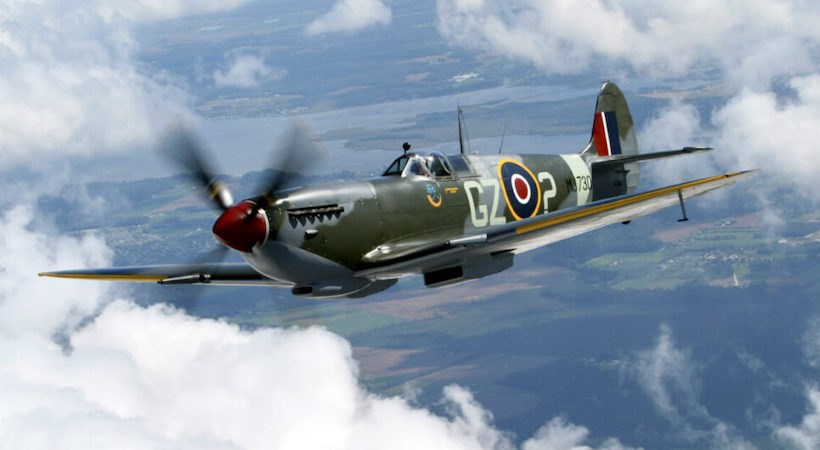

Designed as a short-range, high-performance interceptor, the Spitfire became a symbol of Britain’s resistance against Germany during the Battle of Britain. Its positive impact on morale and superlative performance in combat have led some to call it “The Airplane that Saved the World.”
Known by her wartime serial number, MJ730, the Museum’s Spitfire flew more than 100 combat missions during WWII. Manufactured at Vickers-Armstrong’s Castle Bromwich Aircraft Factory, MJ730 was test-flown by the legendary Alex Henshaw on December 10, 1943. She was soon shipped to Casablanca, Morocco aboard the S.S. Leeds City.
MJ730 saw her first combat missions with No.417 Squadron, Royal Canadian Air Force defending the Anzio Beachhead via a base in Marcianise, Italy. Reassigned to No.154 Squadron, Royal Air Force (RAF), MJ730 flew 95 combat missions supporting the invasion of Southern France from a base at Poretta on the Mediterranean island of Corsica. In October 1944, the fighter joined No. 32 Squadron RAF in Kalamaki, Greece. During this time, MJ730 flew 12 combat missions over the Balkans before finally moving on to No. 94 Squadron, RAF in Sedes, Greece.
Following WWII, MJ730 became part of the re-established Italian Air Force, and eventually joined the fledgeling Israeli Air Force. After its retirement from Israeli service, the Spitfire ended up as a play thing on a Kibbutz Kabri near the Lebanese border, which is where the British warbird salvager, Robs Lamplough, found her in 1976. Lamplough acquired the aircraft and recovered her back to Britain for restoration in 1978; MJ730 making her first post-restoration flight a decade later.
Squadron Leader George Frederick Silvester, DFC: When MJ730 first arrived at No. 32 Squadron, Squadron Leader George Silvester made her his personal aircraft. Before an individual aircraft code could be applied to MJ730, Silvester had remarked to his ground crew that “There was a bit of a question mark” over which identifier to use, since a squadron’s Commanding Officer (CO) belongs to neither of its two flights. As a joke, the ground crew applied a question mark to MJ730’s fuselage, but the gesture amused Silvester so he chose to keep it! The airplane has since been referred to as “The CO’s Query.”
Silvester was born in Gravesend, England on November 9, 1920. He began flight training in the RAF Volunteer Reserve during April 1939, but the outbreak of war just a few months later saw him become a full-time trainee. Silvester flew Hurricanes as a Sergeant pilot with No.229 Squadron from RAF Northolt at the tail end of the Battle of Britain, receiving his commission as a Pilot Officer with No.145 Squadron at RAF Tangmere in early December, 1941. In mid-1942, Sylvester helped train American pilots of the 52nd Pursuit Group how to fly Spitfires. After a period flying combat over North Africa, and a break as an instructor, Sylvester took command of No. 32 Squadron in Foggia, Italy during July, 1944, later moving with the unit to Greece. Silvester survived the war and married Section Officer Elizabeth Maureen O’Donohughe WAAF in July 1946.